Critical role for perforin-, Fas/FasL-, and TNFR1-mediated cytotoxic pathways in down-regulation of antigen-specific T cells during persistent viral infection
- PMID: 11752172
- PMCID: PMC136836
- DOI: 10.1128/jvi.76.2.829-840.2002
Critical role for perforin-, Fas/FasL-, and TNFR1-mediated cytotoxic pathways in down-regulation of antigen-specific T cells during persistent viral infection
Abstract
Viral persistence following infection with invasive strains of lymphocytic choriomeningitis virus (LCMV) can be achieved by selective down-regulation of virus-specific T lymphocytes. High viral burden in the onset of infection drives responding cells into functional unresponsiveness (anergy) that can be followed by their physical elimination. In this report, we studied down-regulation of the virus-specific CD8(+)-T-cell response during persistent infection of adult mice with LCMV, with emphasis on the role of perforin-, Fas/FasL-, or tumor necrosis factor receptor 1 (TNFR1)-mediated cytolysis in regulating T-cell homeostasis. The results reveal that the absence of perforin, Fas-ligand, or TNFR1 has no significant effect on the kinetics of proliferation and functional inactivation of virus-specific CD8(+) T cells in the onset of chronic LCMV infection. However, these molecules play a critical role in the homeostatic regulation of T cells, influencing the longevity of the virus-specific CD8(+)-T-cell population once it has become anergic. Thus, CD8(+) T cells specific to the dominant LCMV NP(396-404) epitope persist in an anergic state for at least 70 days in perforin-, FasL-, or TNFR1-deficient mice, but they were eliminated by day 30 in C57BL/6 controls. These effects were additive as shown by a deficit of apoptotic death of NP(396-404) peptide-specific CD8(+) T cells in mice lacking both perforin and TNFR1. This suggests a role for perforin-, FasL-, and TNFR1-mediated pathways in down-regulation of the antiviral T cell response during persistent viral infection by determining the fate of antigen-specific T cells. Moreover, virus-specific anergic CD8(+) T cells in persistently infected C57BL/6 mice contain higher levels of Bcl-2 and Bcl-XL than functionally intact T cells generated during acute LCMV infection. In the case of proapoptotic factors, Bax expression did not differ between T-cell populations and Bad was below the limit of detection in all samples. As expression of the Bcl-2 family members controls susceptibility to apoptosis, this finding may provide a molecular basis for the survival of anergic cells under conditions of prolonged antigen stimulation.
Figures
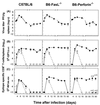
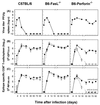
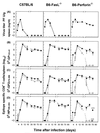

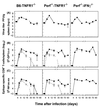
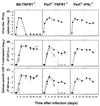


Similar articles
-
Aplastic anemia rescued by exhaustion of cytokine-secreting CD8+ T cells in persistent infection with lymphocytic choriomeningitis virus.J Exp Med. 1998 Jun 1;187(11):1903-20. doi: 10.1084/jem.187.11.1903. J Exp Med. 1998. PMID: 9607930 Free PMC article.
-
Reduction of antiviral CD8 lymphocytes in vivo with dendritic cells expressing Fas ligand-increased survival of viral (lymphocytic choriomeningitis virus) central nervous system infection.J Immunol. 2002 Nov 1;169(9):4867-72. doi: 10.4049/jimmunol.169.9.4867. J Immunol. 2002. PMID: 12391197
-
Constitutive expression of Bcl-xL or Bcl-2 prevents peptide antigen-induced T cell deletion but does not influence T cell homeostasis after a viral infection.Eur J Immunol. 1998 Feb;28(2):560-9. doi: 10.1002/(SICI)1521-4141(199802)28:02<560::AID-IMMU560>3.0.CO;2-Q. Eur J Immunol. 1998. PMID: 9521066
-
Perforin: more than just an effector molecule.Immunol Today. 2000 Jun;21(6):254-6. doi: 10.1016/s0167-5699(00)01622-4. Immunol Today. 2000. PMID: 10825735 Review. No abstract available.
-
Complexities of Type I Interferon Biology: Lessons from LCMV.Viruses. 2019 Feb 20;11(2):172. doi: 10.3390/v11020172. Viruses. 2019. PMID: 30791575 Free PMC article. Review.
Cited by
-
Regulation of anoikis by extrinsic death receptor pathways.Cell Commun Signal. 2023 Sep 4;21(1):227. doi: 10.1186/s12964-023-01247-5. Cell Commun Signal. 2023. PMID: 37667281 Free PMC article. Review.
-
Pathogenic epitopes, heterologous immunity and vaccine design.Nat Rev Microbiol. 2007 Jul;5(7):555-63. doi: 10.1038/nrmicro1709. Nat Rev Microbiol. 2007. PMID: 17558423 Free PMC article. Review.
-
Structural and mechanistic features of protein O glycosylation linked to CD8+ T-cell apoptosis.Mol Cell Biol. 2007 Feb;27(3):1096-111. doi: 10.1128/MCB.01750-06. Epub 2006 Nov 13. Mol Cell Biol. 2007. PMID: 17101770 Free PMC article.
-
T cell exhaustion.Nat Immunol. 2011 Jun;12(6):492-9. doi: 10.1038/ni.2035. Nat Immunol. 2011. PMID: 21739672 Review.
-
Comparison of cytotoxic T lymphocyte efficacy in acute and persistent lymphocytic choriomeningitis virus infection.Proc Biol Sci. 2011 Nov 22;278(1723):3395-402. doi: 10.1098/rspb.2011.0453. Epub 2011 Mar 30. Proc Biol Sci. 2011. PMID: 21450739 Free PMC article.
References
-
- Ahmed, R., L. A. Morrison, and D. M. Knipe. 1996. Persistence of viruses, p.219–249. In B. N. Fields, D. M. Knipe, and P. M. Howley (ed.), Fields virology, 3rd ed., vol. 1. Lippincott-Raven, Philadelphia, Pa.
-
- Ahmed, R., A. Salmi, L. D. Butler, J. M. Chiller, and M. B. A. Oldstone. 1984. Selection of genetic variants of lymphocytic choriomeningitis virus in spleen of persistently infected mice: role in suppression of cytotoxic T lymphocyte response and viral persistence. J. Exp. Med. 160:521–540. - PMC - PubMed
-
- Altman, J. D., P. A. H. Moss, P. J. R. Goulder, D. H. Barouch, M. G. McHeyzer-Williams, J. I. Bell, A. J. McMichael, and M. M. Davis. 1996. Phenotypic analysis of antigen-specific T lymphocytes. Science 274:94–96. - PubMed
Publication types
MeSH terms
Substances
Grants and funding
LinkOut - more resources
Full Text Sources
Molecular Biology Databases
Research Materials
Miscellaneous

